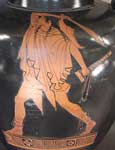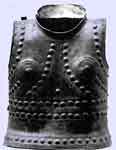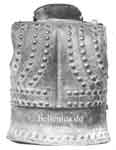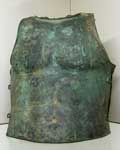.
Part 1 - 2
Now when Dawn in robe of saffron was hasting from the streams of Oceanus, to bring light to mortals and immortals, Thetis reached the ships with the armour that the god had given her. She found her son fallen about the body of Patroclus and weeping bitterly. Many also of his followers were weeping round him, but when the goddess came among them she clasped his hand in her own, saying, "My son, grieve as we may we must let this man lie, for it is by heaven's will that he has fallen; now, therefore, accept from Vulcan this rich and goodly armour, which no man has ever yet borne upon his shoulders." As she spoke she set the armour before Achilles, and it rang out bravely as she did so. The Myrmidons were struck with awe, and none dared look full at it, for they were afraid; but Achilles was roused to still greater fury, and his eyes gleamed with a fierce light, for he was glad when he handled the splendid present which the god had made him. Then, as soon as he had satisfied himself with looking at it, he said to his mother, "Mother, the god has given me armour, meet handiwork for an immortal and such as no living could have fashioned; I will now arm, but I much fear that flies will settle upon the son of Menoetius and breed worms about his wounds, so that his body, now he is dead, will be disfigured and the flesh will rot." Silver-footed Thetis answered, "My son, be not disquieted about this matter. I will find means to protect him from the swarms of noisome flies that prey on the bodies of men who have been killed in battle. He may lie for a whole year, and his flesh shall still be as sound as ever, or even sounder. Call, therefore, the Achaean heroes in assembly; unsay your anger against Agamemnon; arm at once, and fight with might and main.", Homer The Iliad, book 19.
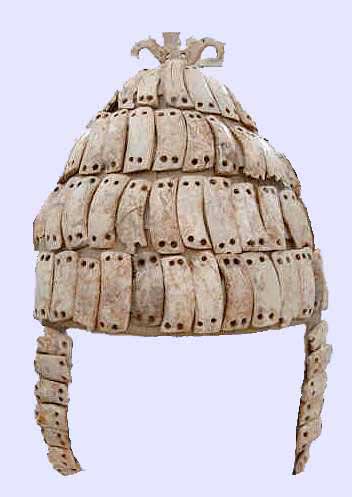
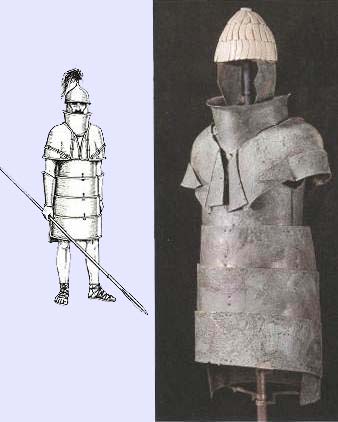

(Comparison with the Asiatic Koryak Armor, c. 1900, Museum of Natural History, negative #1543)
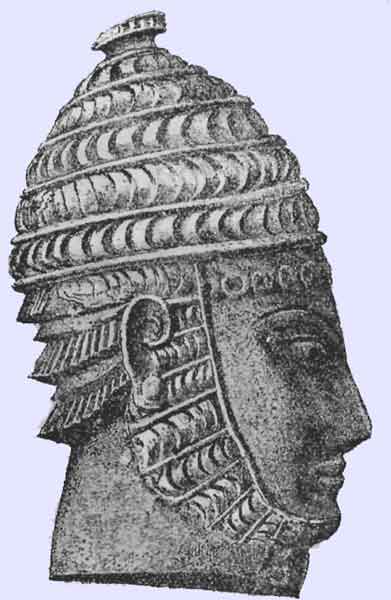
Mycenaean Helmet (Ivory Head sculpture)
On his head he put
a helmet made of leather, without crest or plume,
what people call a skull-cap. It protected heads
of brave young men. Meriones gave Odysseus
bow, quiver, and a sword. On his head Odysseus set
a hide cap, on the inside skillfully reinforced
with leather thongs. Outside, wild boars' white teeth
were placed here and there, strategically and well.
In between these layers was a piece of felt.
This cap had once been stolen by Autolycus,
from Amyntor, Ormenus' son. He'd broken in
his well-built home in Eleon. Some time later,
Autolycus gave it to Amphidamas of Cythera,
to take to his home in Scandeia. Amphidamas
then gave the cap to Molus, as a present
for his hospitality. Molus later gave it
to his son Meriones. And now it sat there,
covering Odysseus' head. Homer, Iliad Book 10
Mycenaean helmet (Boar's tusk helmet), maybe used by the warriors in the Trojan war and Mycenaean armor not like the hoplites later used or the Troy film suggested :-). The example from around 1450 BC was found in Mycenae, Dendra / Midea (Dendra Panoply). Was this panoply used by charioteers? It is assumed that it was too heavy and not flexible enough to allow fast movements for a foot soldier but it could be used as armour of a warrior on a chariot who had a long spear as a weapon. This example belongs to some important person found in a tomb in Dendra and now can be seen in the archaeological museum of Nauplio , Greece. (Image from J. Warry, Warfare in the classical world) A modern reconstruction of the Dendra panoply . Another Dendra armor drawing
J. Chadwick, The Mycenaean World (New York, 1976), 159-79. [Ch. 9, Weapons and War]. (PDF File)
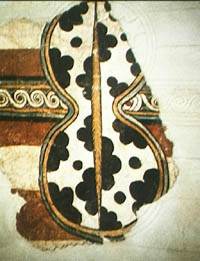

A Mycenaean 8 shield (due to its shape, fresco and drawing) (National Archaeological Museum Athens, 1300-1200 BC)
Mycenaean Soldier Relief from the Archaeological Museum of Delos
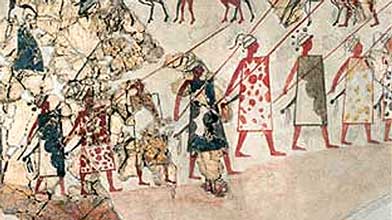
Soldiers with large shields and spears from Akrotiri , Santorini
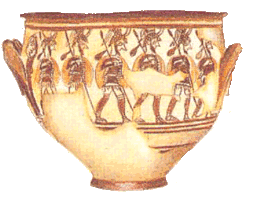
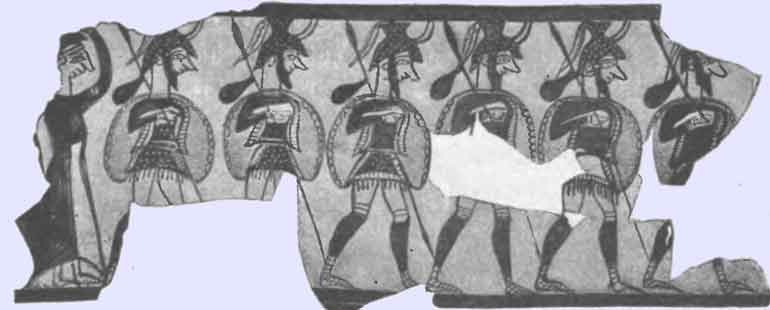
ἐν δορὶ μέν μοι μᾶζα μεμαγμένη, ἐν δορὶ δ' οἶνος
Iσμαρικός· πίνω δ' ἐν δορὶ κεκλιμένος.
Mycenean Soldiers with a bottle wine on their spears as the poet Archilochus explains in his poem
11th century B.C. Helmet, Tiryns, Archaeological Museum of Nauplion
Chadwick Weapons and War (PDF)

Hoplite Armour (includes some less used parts such as perimerides, pericheirida, perisphyra)
The defensive armour most used consisted of four pieces: helmet (kranos), cuirass (thorax), shield (aspis) and greaves (knimis). A weapon is called hoplon from which panoply and hoplite (a man with weapons) is derived (initially the shield was called hoplon (όπλον) but today hoplon is a general name for weapon). It was kept holding the antilabe in the border of the shield.
The offensive armour consisted of two spears (dori or dory) and a sword (xyfos). These six pieces of armour are estimated to have weighted about 35 kg. The hoplite carried them all, however, only in action. (WM). The macedonian army used a special long version of spear, the so-called sarissa (pl. sarissai) with a smaller head.
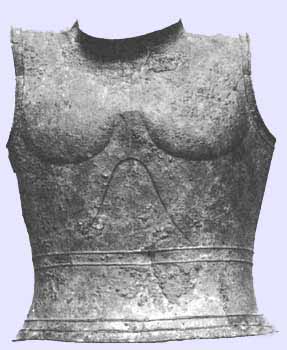
Thorax, Breastplate or Cuirass (Corslet). Eight century BC Argos (Example of the so called Argos panoply). A so called muscle cuirass that imitates musculatur of the body. It was used as a protection like todays bulletproof vests (but much less effective due to the material used). Two parts ; one for the protection of the breast and abdomen, the other for the back. These were hinged on one side and buckled on the other. They were kept in place by leathers straps passing over the shoulders from behind and fastened in front and by a belt (zoni). About the lower part of the thorax was a series of flaps (pteriges) of leather covered with metal, which protected the hips and groin of the wearer, while not in the least interfering with his freedom of movement. (WM)
Front of a cuirass, 4th century BC
Decorative Amazonomachy reliief on a cuirass
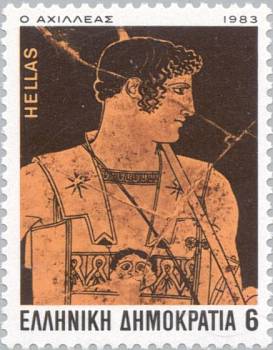
Achilles wearing a so-called composite cuirass, image from a 460-450 BC red figure amphora (the artist is the so-called Achilles Painter), Vatican Museum. Why does Achilles needs a cuirass or any protection armor? Is his body not completely protected after a bath in the Styx river?
Cuirassed torso , NAMABG MA599, (Color reconstruction)

Now, of the above nations the Carians are a race who came into the mainland from the islands. In ancient times they were subjects of king Minos, and went by the name of Leleges, dwelling among the isles, and, so far as I have been able to push my inquiries, never liable to give tribute to any man. They served on board the ships of king Minos whenever he required; and thus, as he was a great conqueror and prospered in his wars, the Carians were in his day the most famous by far of all the nations of the earth. They likewise were the inventors of three things, the use of which was borrowed from them by the Greeks; they were the first to fasten crests on helmets and to put devices on shields, and they also invented handles for shields. Herodotus, Histories Book 1
Helmet or in Greek Kranos (Eng. cranium). The helmet consisted of six pieces: The Cap, conformed to the shape of the head; the Falos, a metal ridge running from the front to the back of the cap at the centre and designed as a support for the crest; the Lofos or crest, commonly of horsehair and constantly ending in the horse's tail; the Visor, the Cheekpieces, and the Neckpiece. The helmet was lined on the inside. It might be solid, when the visor had openings for the eyes and mouth and a projecting nose guard, and the helmet was put on by pulling it down from above over the face; or the visor might be a simple movable guard for the forehead, and the cheekpieces hinged, so that the could be thrown up. The falos was sometimes lacking and the crest supported, high above the head, by a rod that fitted into the centre of the cap. (WM)
Now this armour saved his son's flesh from destruction.
Meges then thrust his sharp spear at Dolops' helmet,
striking it on top, on the bronze ridge, which held in place
the horsehair plume. He sheared it off. The whole plume,
a bright fresh purple, fell down onto the dusty ground.
While Meges fought on, still expecting victory,
warlike Menelaus came to his assistance.
Standing to one side, out of Dolops' line of sight,
Menelaus speared his shoulder from behind.
The eager spear kept going, driving into Dolops' chest.
Homer Iliad 15
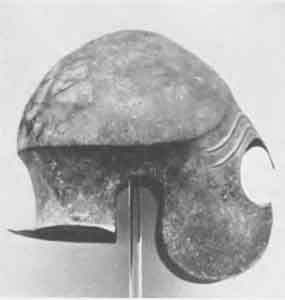
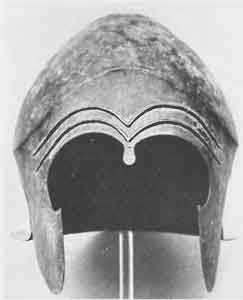
Attic Helmet
The Corinthian helmet (κόρυς κορινθίη) developed in the 8th century BC. Made from a single piece of bronze adapted individually for each warriors. A problem is that it provided bad vision and it was difficult to hear with this helmet. It was the most used type of helmets by the Greeks.
The Ausean maidens keep year by year a feast in honour of Minerva, whereat their custom is to draw up in two bodies, and fight with stones and clubs. They say that these are rites which have come down to them from their fathers, and that they honour with them their native goddess, who is the same as the Minerva (Athene) of the Grecians. If any of the maidens die of the wounds they receive, the Auseans declare that such are false maidens. Before the fight is suffered to begin, they have another ceremony. One of the virgins, the loveliest of the number, is selected from the rest; a Corinthian helmet and a complete suit of Greek armour are publicly put upon her; and, thus adorned, she is made to mount into a chariot, and led around the whole lake in a procession. Herodotus, Histories Book 4.
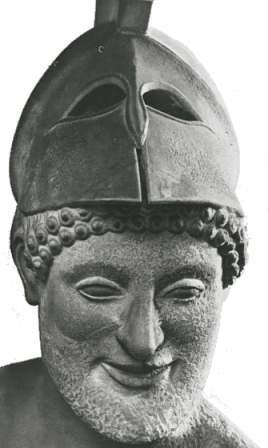
Often images and sculptures of various persons wearing this helmet pushed back on the head. Replaced by other types more open-faced after the 5th century BC.
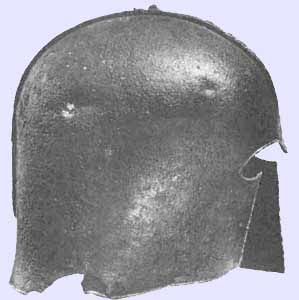
First half of 7-th Century BC. Corinthian Helmet
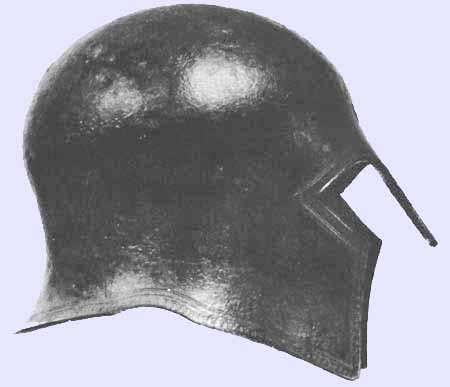
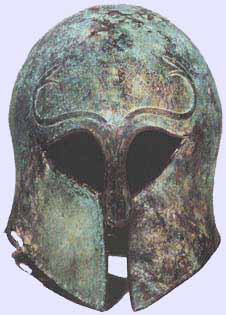
Second half of 7-th Century BC. Two Corinthian Helmets
Corinthian helmet Denda Staatliche Antikensammlungen 4330
Corinthian helmet 7th-6th century BC
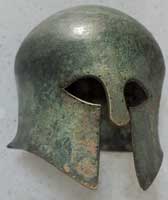
Corinthian Helmet , Louvre, Br4491
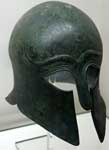
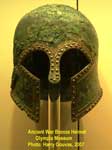
Corinthian Helmet, 510–-480 B.C. Museum of Fine Arts, Boston
Apulo-Corinthian Helmet, 400-375 BC (High Resolution Images : Drawings and the Helmet )
Sculpture of a soldier with a beard and a Corinthian Helmet from Cyprus

Papaflessas with a corinthian helmet at Maniaki 1825, Greek Stamp of 1975
The Illyrian helmet from Peloponnese 7th century BC. Made by two pieces joined together at the crown. Two ridges running along either side of the seam provided an extra protection. Gold funerary mask with bronze 'Illyrian' helmet , Bronze helmet Illyrian Type 6th century BC
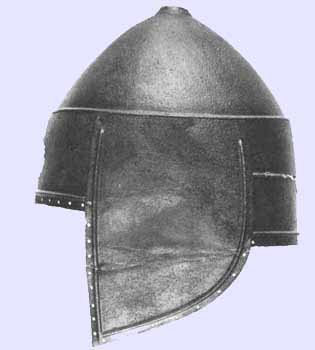
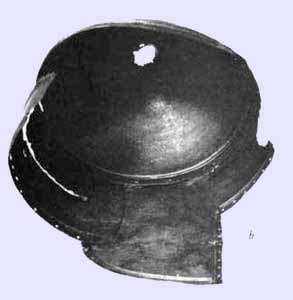
700 BC Kegel Helmet b) Helmet interior. This helmet was made of several bronze pieces.
Chalcidian helmet. Bronze. Greek, 2nd half of the 6th century BC.
The Chalcidian helmet used mostly by Greeks in the West or in Italy. A version of the Corinthian with openings for the ears. Often decorated with lines or more complex drawings. Helmet of Chalkidian Shape
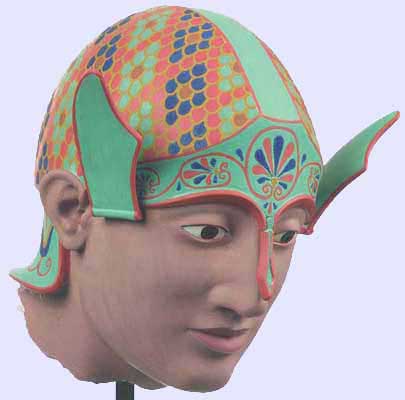
A color reconstruction of a Chalcidian warrior Helmet of a sculpture in the Aphaia Temple

A Scythian helmet (seen in Greek sculptures or paintings, image above probably Paris from Troy. In the background left the sculpture of Paris today with other figures showing the second Trojan war with Athena as a central figure watching. Scythian archers worked as mercenaries for Greek armies. At the battle of Salamis the Greeks hired 300 Scythian mercenaries. Usually 1/3 of the Scythians archers were women so that it is possible that not only men were fighting in Salamis but also around 100 women. Also the Persian army had women. Artemisia I, ruler of Halicarnassus and Cos worked for the Persian King Xerxes and during the Salamis naval battle she was a commander of a few ships.

Illyrian helmet. Bronze. Greek, 6th-5th century BC. From Argolis.
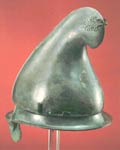
A Macedonian helmet ( a phrygian version) (Ioannina Museum, Greece), usually for the infantry with a blue color, 4th century BC found in Vitsa Epirus, see Macedonian helmet (from which this image is taken) and the image of an Iron Macedonian helmet from the tomb of Philip.
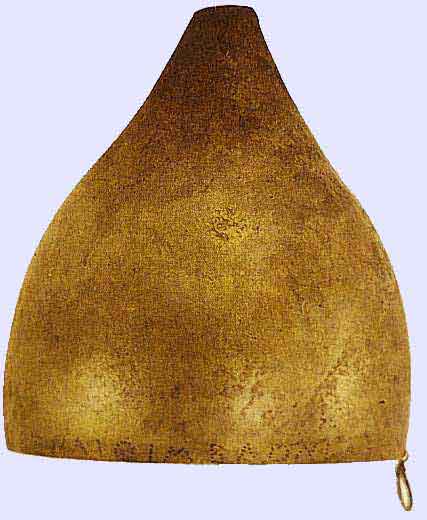
Persian Helmet in Olympia after Marathon victory
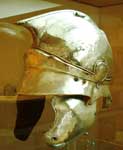
Hellenistic Helmet, Corfu Archaeological Museum
Of sponges there are three species; the first is of loose porous texture, the second is close textured, the third, which is nicknamed ‘the sponge of Achilles’, is exceptionally fine and close-textured and strong. This sponge is used as a lining to helmets and greaves, for the purpose of deadening the sound of the blow; and this is a very scarce species. Aristotle, History of Animals
14th and 15th centuries Venetian Helmets from Chalkida.
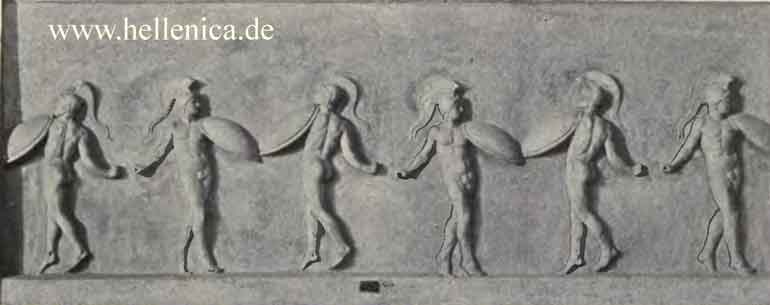
Dance in Armour, Vatican Museum
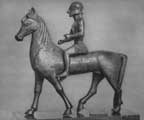
Warrior, The 'Armento Rider', British Museum

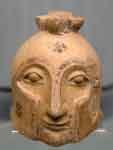
Aryballos head Corinthian helmet c. 600 BC
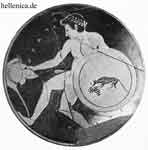
Youth with greaves holding a corinthian helmet.
Part 1 - 2
| Ancient Greece
Science, Technology , Medicine , Warfare, , Biographies , Life , Cities/Places/Maps , Arts , Literature , Philosophy ,Olympics, Mythology , History , Images Medieval Greece / Byzantine Empire Science, Technology, Arts, , Warfare , Literature, Biographies, Icons, History Modern Greece Cities, Islands, Regions, Fauna/Flora ,Biographies , History , Warfare, Science/Technology, Literature, Music , Arts , Film/Actors , Sport , Fashion --- |


